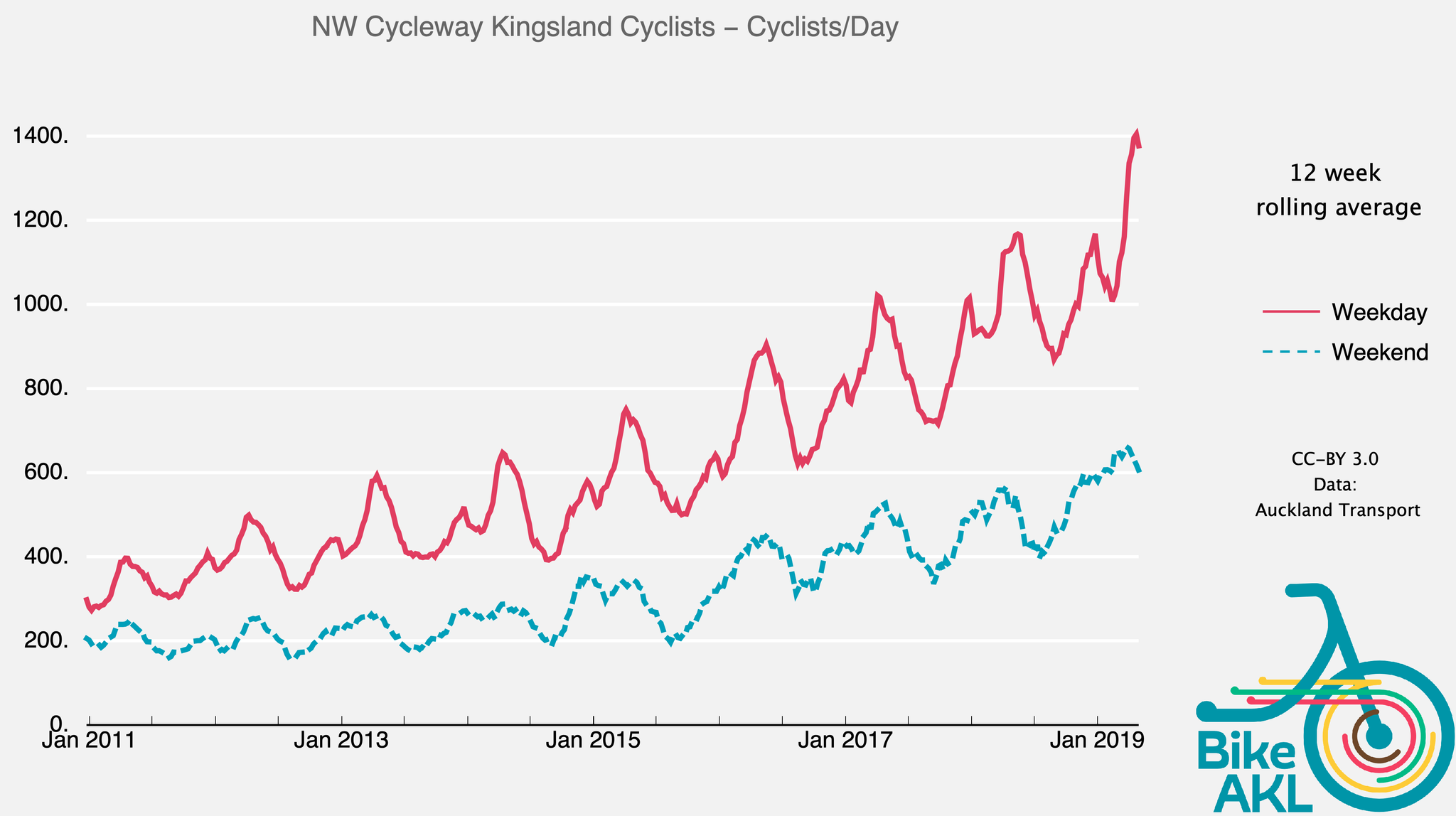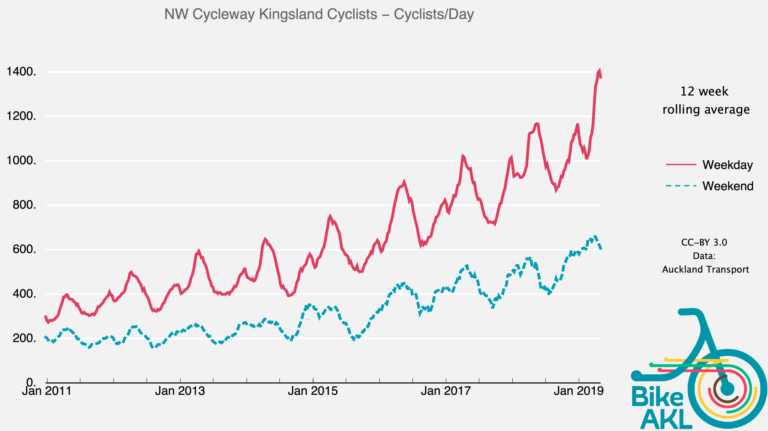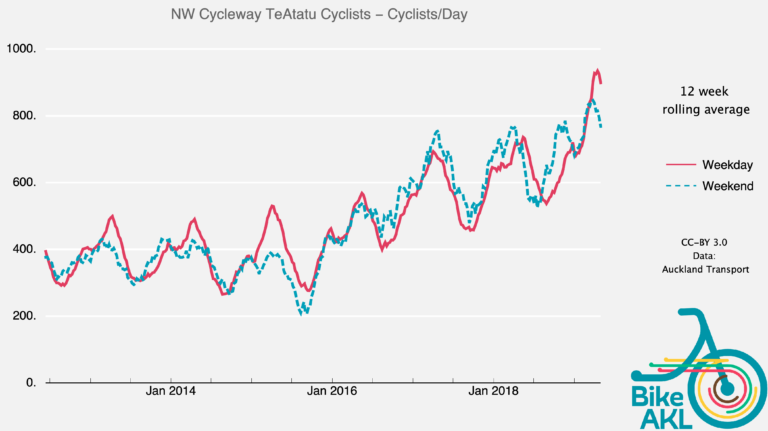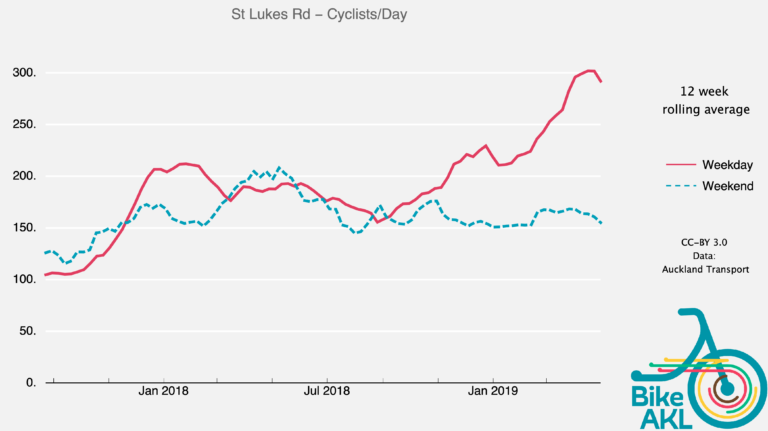You may have heard the story on the news about Auckland being the 7th best cycling city in the world, just after Amsterdam and Malmo, and above Melbourne, Berlin, and Tokyo.
Really?? Some days it might almost be starting to feel like it! But as our chair Barb says in the audio version of the story, “Auckland’s doing some fabulous projects, but it’s just way too slow. Think about it: 7.5km from Glen Innes to Tamaki Drive – people are so hungry for that connection from the eastern part of the city, but it just makes me weep because it’s so slow.” (See also our April Project Watch, for the ups and downs of infrastructure delivery).
When you read the fine print on the “Global Bicycle Cities Index”, you’ll find it was whipped up by German insurance company Coya, which seems to have compared apples with oranges, extrapolating Auckland’s status – somewhat misleadingly – from a single data point.
What was that data point? A couple of years ago in a sample-based survey for Auckland Transport, 31% of Aucklanders said they rode a bike ‘at least occasionally.’ That’s great, but it really doesn’t put us cheek-by-jowl with Amsterdam on a daily basis.
(Well, not yet. As a mode share, cycling is still in the single digits. Although once the census data finally comes out, we may find that some of the inner west burbs – which were knocking on 4-5% bike-to-work share in 2013 – have even more people regularly travelling by bike).
But here’s the thing. The same survey carried out again in 2018 found that 38% of Aucklanders now put themselves in the ‘occasional rider’ category. And 23% of Aucklanders ride a bike at least monthly.
So, while #7 in the world is a bit of a stretch, things are definitely improving!
And when it comes to where Aucklanders are riding, you’ll find a fascinating shift. Firstly, of course, there’s the ‘network effect’ we’ve been observing for the last several years, with people flocking to safe routes, especially when they’re joined up.
Secondly, the bike boom on cycleways and key bike routes is happening in biking for daily transport, rather than weekend fresh air.
Once upon a time, you’d have been looking at a hard core of brave commuters, versus weekend explorers out for fun, with some overlap, of course.
Now, the most dramatic growth on the cycle counters is firmly and clearly in Monday to Friday weekday travel.
Take Tamaki Drive, for example. On our busiest bike route, back in 2012-2014, there were more riders on an average weekend day than on a weekday. You can see the seasonal ups and downs. But spot the shift: around 2015, the numbers start to even out, with weekday riders gaining an edge. And then look at the leap since spring!
(Note: the little downward fishhook at the end represents this year’s overlap of Easter and Anzac Day, which meant many people took the last week of April off work).
You can see the same phenomenon on Nelson St, which opened in 2016. It started with almost equal balance of weekday workers and weekend explorers, but quickly the weekday travel gained an edge. And then, after steadyish growth in its first two years, BOOM. A rapid leap in weekday riders; and this April is up 8% over last April!
Recall this is the cycleway that confounded some people in the media, by not hitting its ten-year target in year one. Based on current form, it’ll hit that target later this year, which is to say, year three, i.e. only seven years ahead of schedule. Just saying.
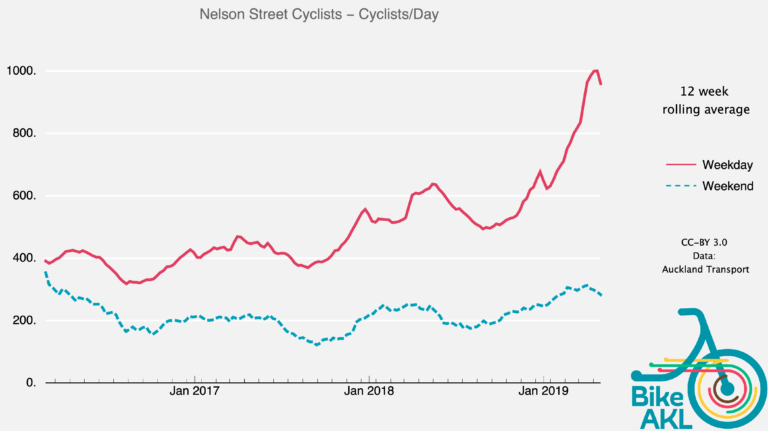
If that recent leap is due to the Ian McKinnon Cycleway effect, you’d expect to see it on the Northwestern Cycleway, too. And whoop, there it is. A steady rise of ~20% year on year, with this year already tracking at 25%. Thanks, Ian McKinnon.
Oh and look, there it is on Upper Queen Street as well.
And on Grafton Gully, too. Yep. Story checks out.
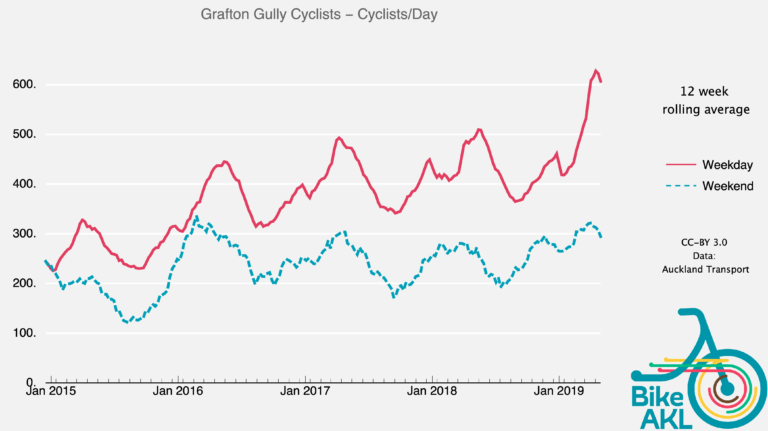
Lightpath is an interesting one. It attracted a whole lot of visitors when it first opened, and that novelty factor eventually tapered off into more regular numbers. This is where little kids come to learn to do skids, tourists to take selfies, and lots of people just for fun; a steady weekend ridership. But is it predominantly carrying weekday traffic, and rising? Yes. Yes it is.
Out west, where e-bikes have put Te Atatu within easy reach of the city for all sorts of riders, you can see the same phenomenon. Look at the steady heartbeat of those long-range commuters in the early years, doing it tough before the causeway widening, before the smooth wide path. And then watch it take off. There’s still a fair volume of weekend riders enjoying the wide flat pathway, relatively free of pedestrians and so on – but in recent months, there it is again: the Monday to Friday crew takes over.
We could go on. We have more graphs for other counters across the city, showing similar patterns – even where the cycleways aren’t protected, upgraded, or especially well-connected to wider routes. Okay, here’s one – Lake Road:
And here’s another: humble old St Lukes Rd.
You want more? We’ve got more. But you get the picture. Aucklanders are increasingly choosing bikes for everyday transport.
The bigger question – and we can only hope that the 2018 census data begins to help answer this – is what’s happening with the kinds of riders and trips that don’t register on the city’s 26 automatic counters?
If you bike every day, but you never make it to a cycleway or travel along a main corridor, do you and your journey matter to the people who decide whether to invest in your safety or not?
If you bike to your local transport hub, but you don’t cross an automatic counter on the way, are you and your journey as valued as every individual who drives there wrapped in a half-ton of steel and then complains there isn’t enough space to park?
If you bike to school every day of the year, do you and your travel needs count?
There are lots of kids across the city who will be asking that question as they come of voting age this year. And lots more who are still too young to vote, but dream of a future in which any old bike ride to school, shops, friends’ place is just as worthy of official measurement and investment as a noble congestion-busting commute to work.
As the planet heats up, every single sustainable journey counts for a great deal. The question isn’t: how on earth did Auckland accidentally find ourselves near the top of a list of great cycling cities? It’s: how fast can we get there on purpose?

